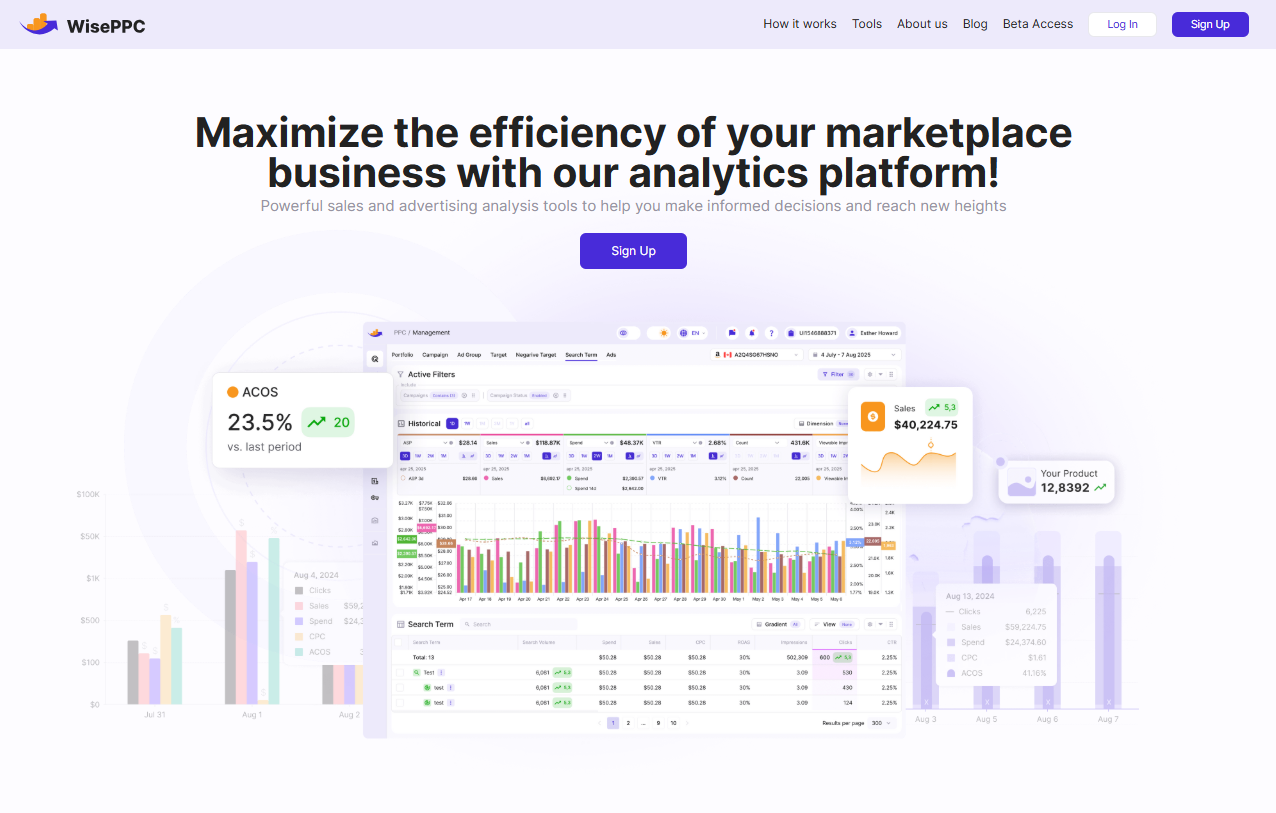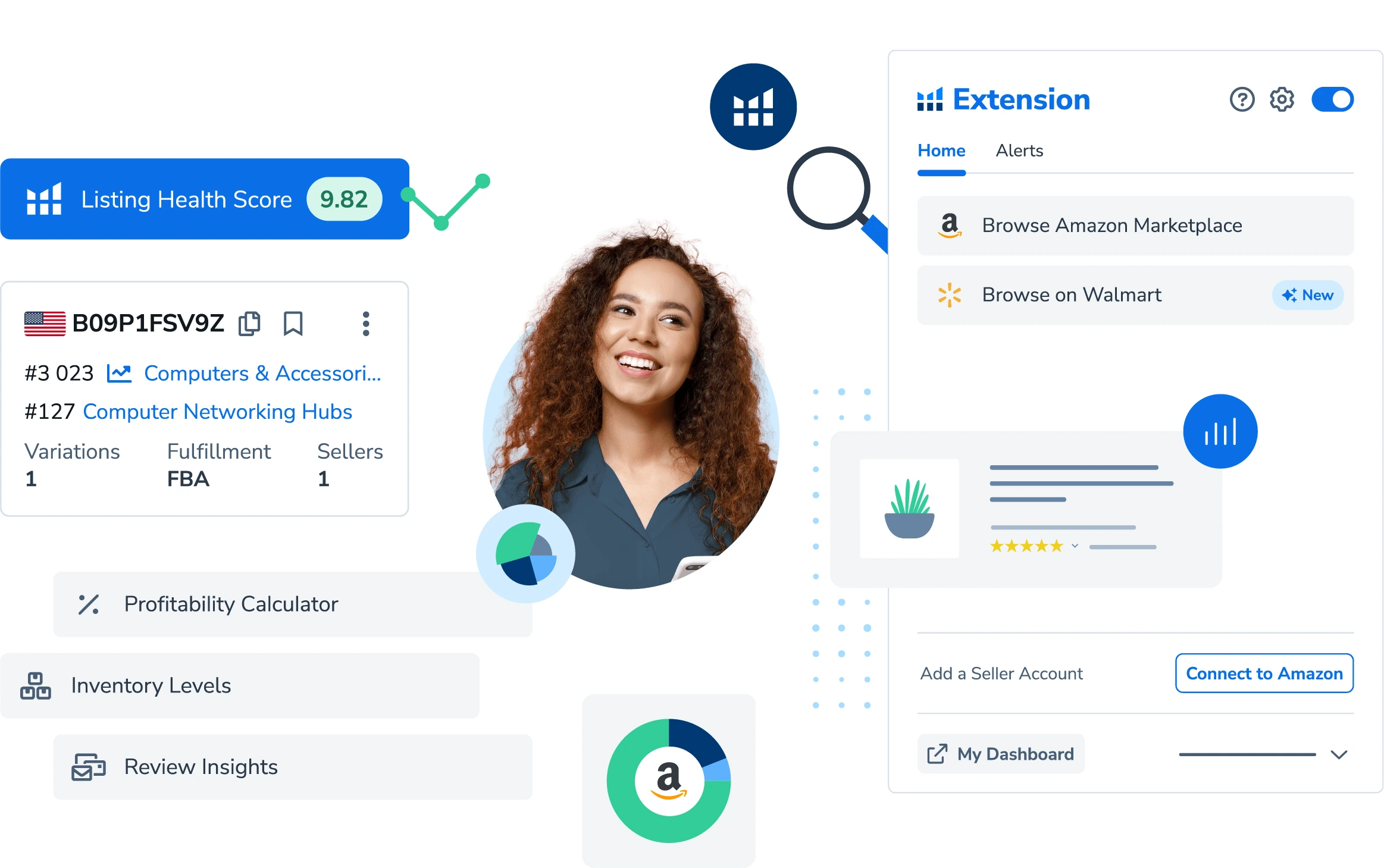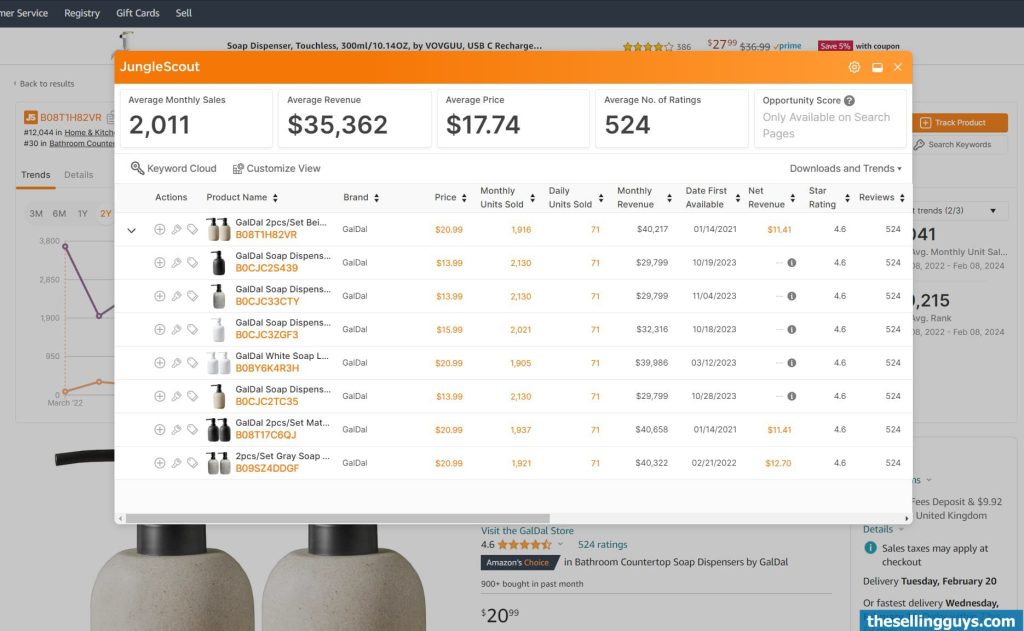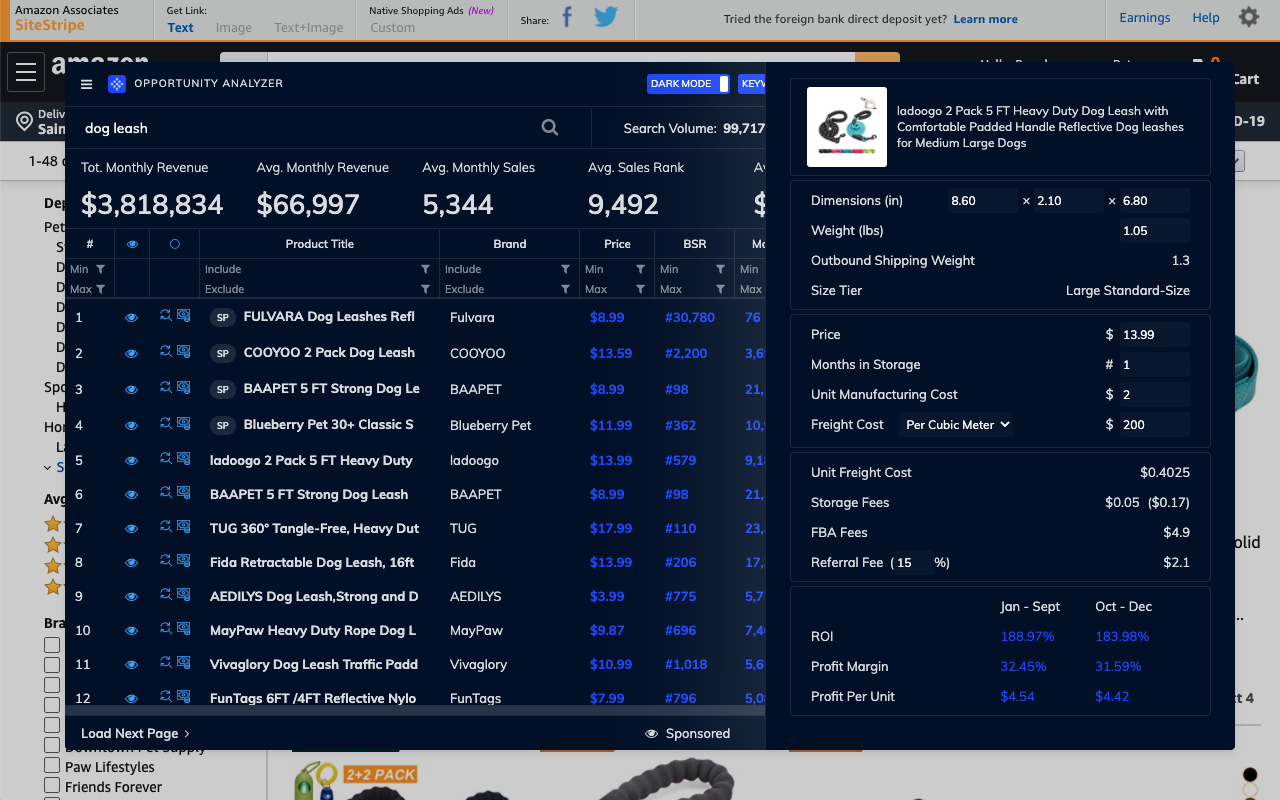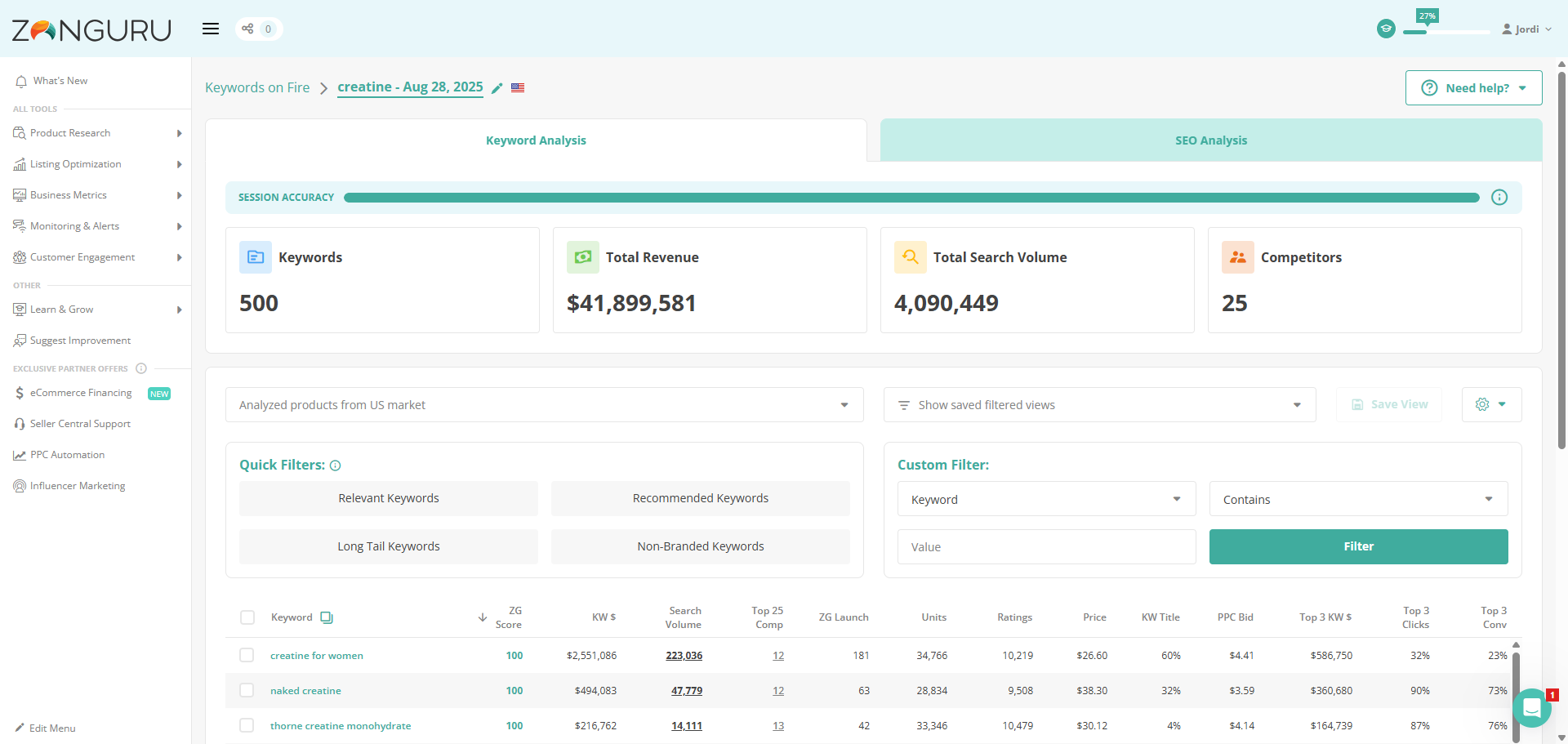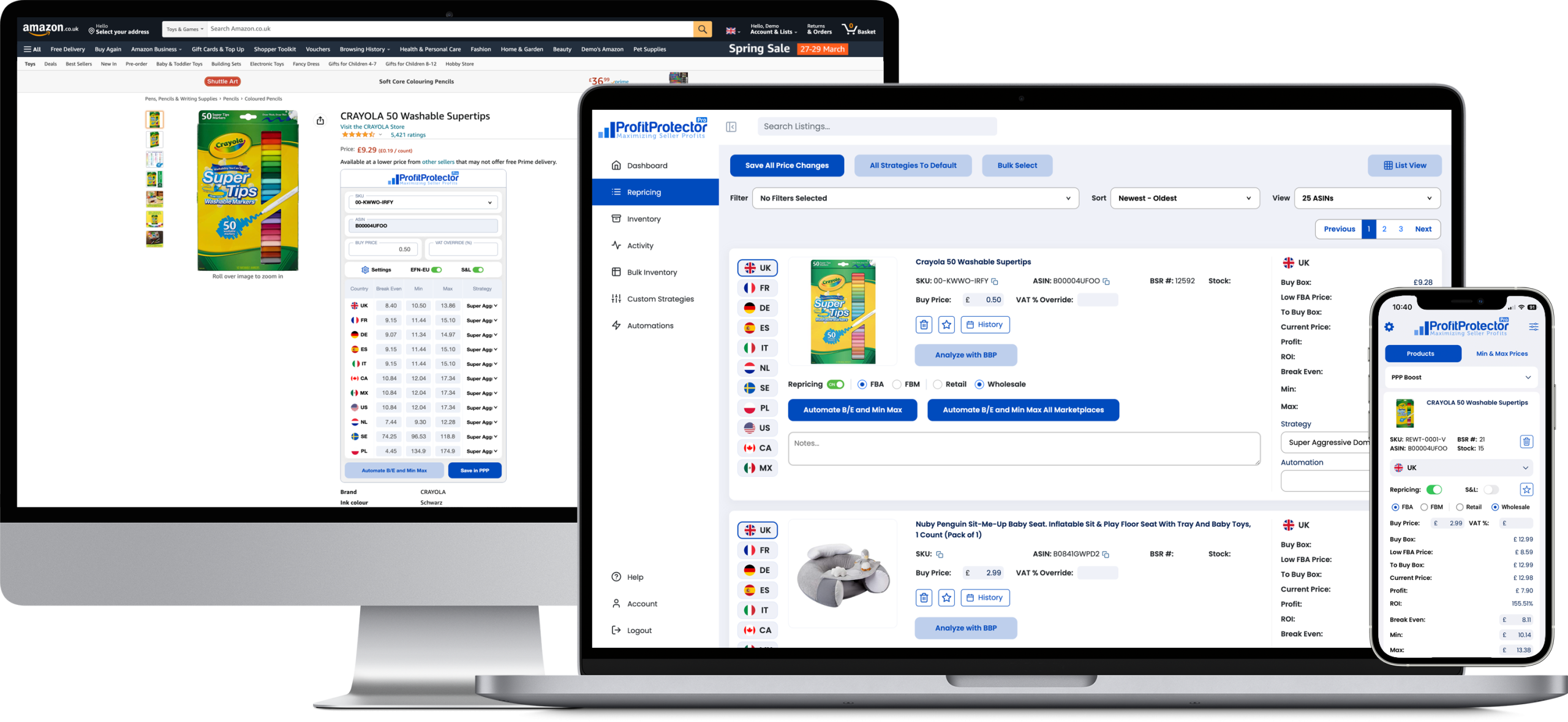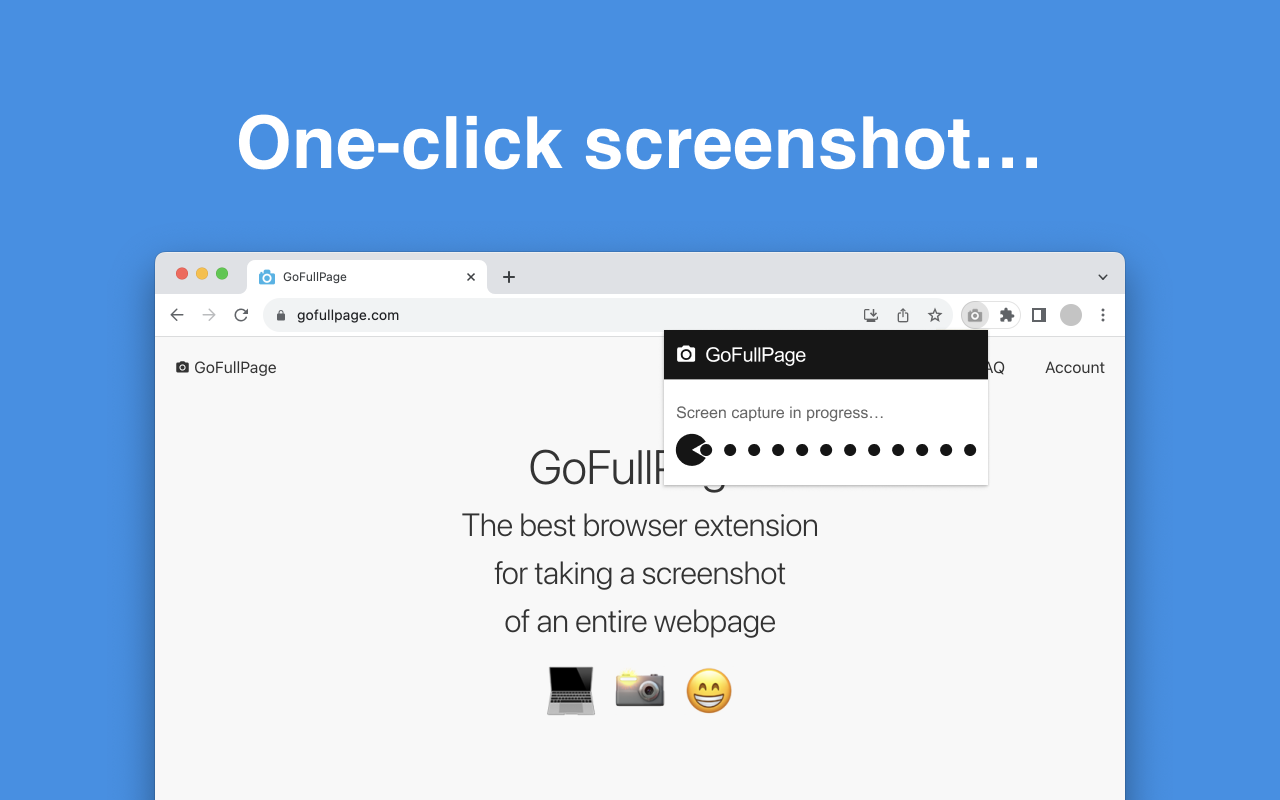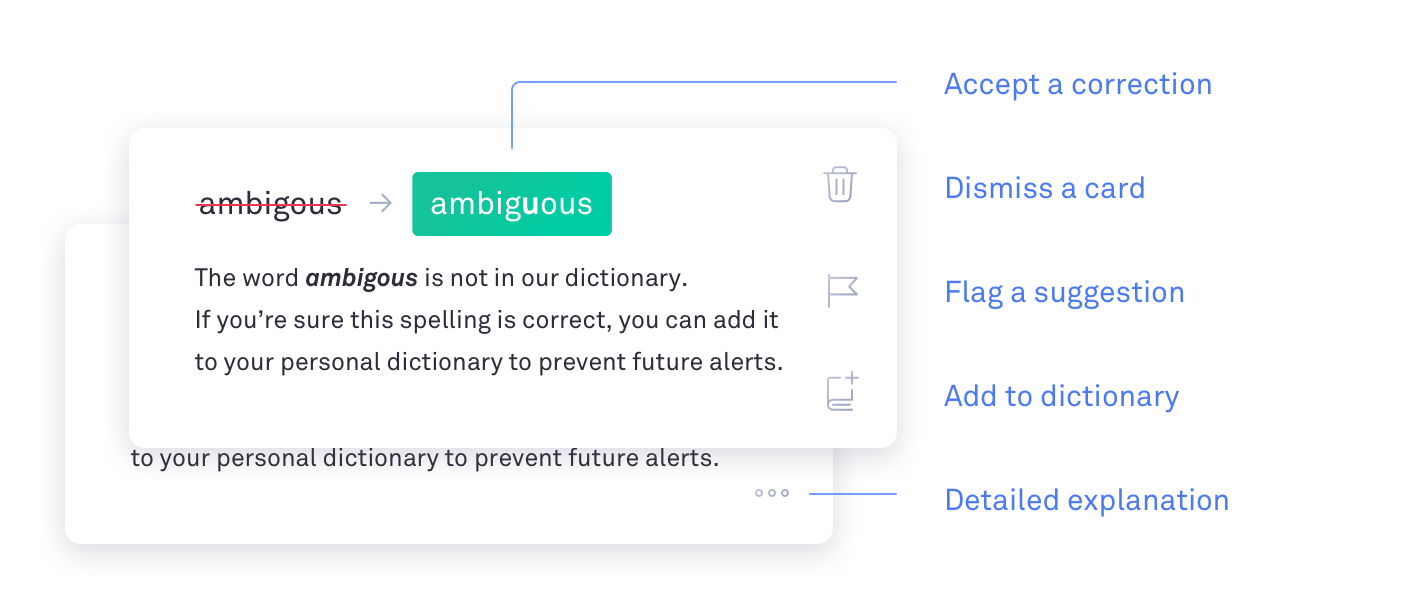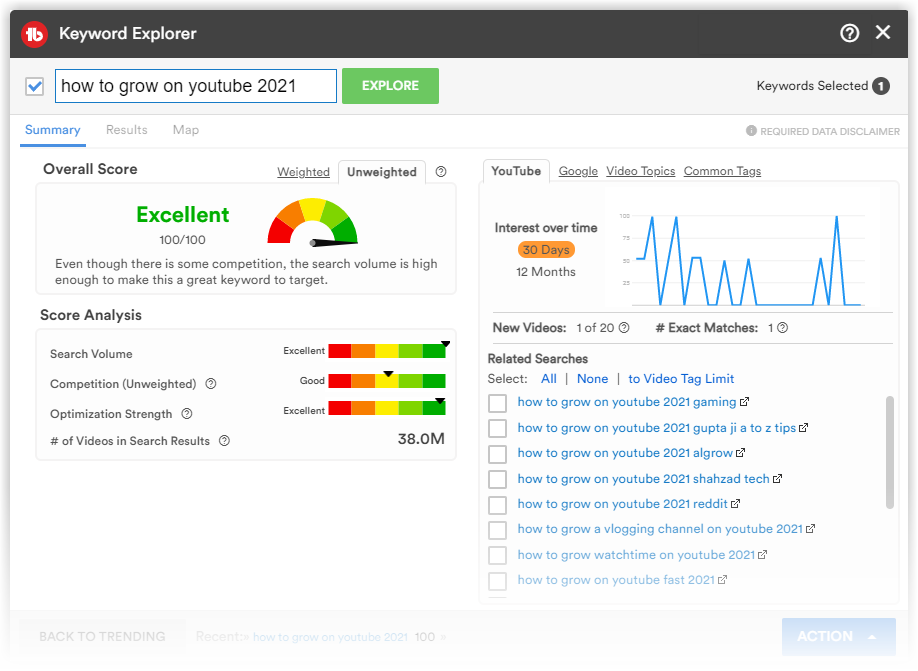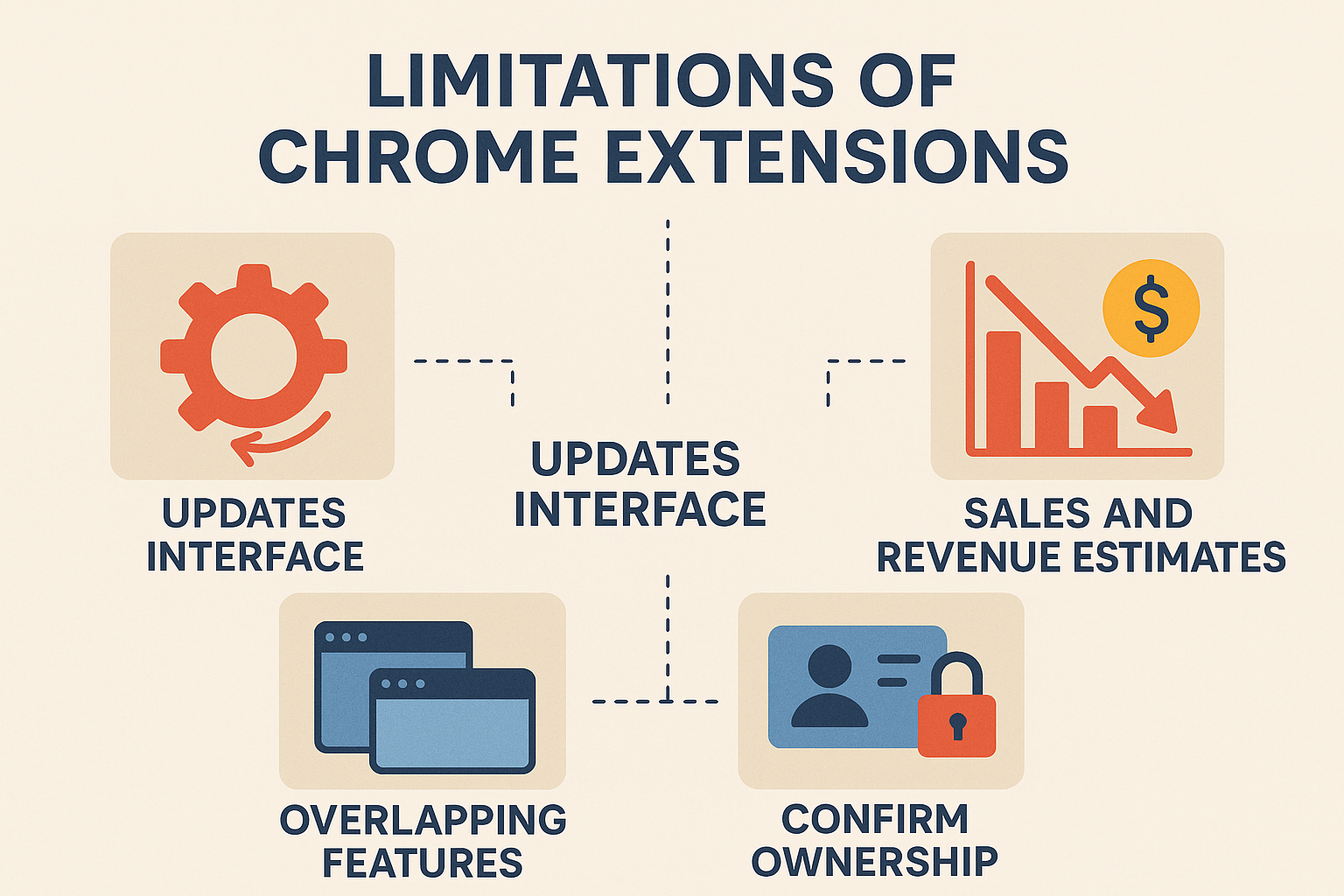Top 10 Google Chrome Extensions for Amazon Sellers in 2025
Selling on Amazon in 2025 is fast-paced, data-heavy, and more competitive than ever. If you’re not using the right tools, you’re probably wasting time, or worse, missing out on profit. Thankfully, Chrome extensions have come a long way. They’re not just browser add-ons anymore; they’re essential gear for serious sellers. From product scouting to tracking profitability and fine-tuning your listings, these extensions bring critical insights straight to your screen, no spreadsheet juggling required. In this guide, we’ll look at the top Chrome extensions worth your attention this year, whether you’re just getting started or running multiple accounts across marketplaces.
Why Chrome Extensions Matter for Amazon Sellers
For Amazon sellers, time really is money. Between managing inventory, running PPC campaigns, and keeping an eye on competitors, there’s a constant need to make fast, informed decisions. That’s where Chrome extensions come in. Instead of jumping between tools, dashboards, and spreadsheets, sellers can get a lot of key insights directly while browsing Amazon’s own interface. It’s not about convenience, it’s about working smarter right at the point of research.
Take competitor analysis, for example. With the right extension, you can instantly see a product’s estimated monthly sales, pricing history, BSR trends, and even how many sellers are on a listing. No need to open extra tabs or run reports elsewhere. When it comes to keyword tracking, Chrome extensions let you evaluate search volume, keyword difficulty, and ranking opportunities in real time while you explore product niches. And for product research, these tools are like having a market analyst built into your browser, spotting best-sellers, checking profitability, and validating ideas on the fly.
Whether you’re just starting out or already running multiple ASINs, having the right extension in your browser bar can shave hours off your weekly workload. It’s a simple shift that turns everyday browsing into actionable insight.
Beyond Extensions: Where WisePPC Fits In
Chrome extensions are great for quick wins – spotting sales trends while browsing, pulling keyword data on the fly, or grabbing insights straight from a product page. But once you’re managing serious ad spend, multiple ASINs, or even selling across marketplaces, you’ll quickly find that extensions only cover part of the picture.
That’s where we come in. At WisePPC, we’ve built more than a browser add-on. We’ve created a full analytics and optimization platform designed for sellers who need deeper visibility and automation. With our system, you can analyze historical performance far beyond Amazon’s 60–90 day limit, track up to six metrics side by side, and take bulk actions across thousands of campaigns in just a few clicks. Features like placement-level analysis, anomaly detection, and on-the-spot editing turn raw data into actionable steps, helping you move faster and make smarter decisions.
What Sets WisePPC Apart:
- It stores long-term data that Amazon doesn’t, letting you track years of performance trends instead of just 60–90 days.
- It supports bulk campaign actions, saving hours of manual editing by allowing you to adjust bids, budgets, and strategies across campaigns at once.
- It highlights outliers and anomalies with gradient-based visuals so you can spot problems before they cost you money.
- It provides placement-level performance insights, showing exactly where your ads perform best.
- It offers multi-metric analysis, letting you compare up to six KPIs at a time for a deeper view of campaign health.
- It enables on-the-spot editing, so you can make real adjustments without jumping between multiple dashboards.
In other words, while Chrome extensions are perfect for quick research and validation, our role is to tie it all together. We centralize your analytics, cut wasted ad spend, and give you the scale to grow confidently across Amazon and beyond.
The Best Chrome Extensions for Amazon Sellers in 2025
There’s no shortage of Chrome extensions promising to make Amazon selling easier, but only a handful truly earn a place in your daily workflow. Some focus on product research, others on pricing trends or ad efficiency, and a few tackle tasks like grammar or visual documentation. Below, we’ve rounded up the ones that stand out in 2025 – tools that help you work faster, make better decisions, and cut down on busywork.
1. Helium 10 Chrome Extension: The All-in-One Research Companion
Helium 10 continues to be one of the most reliable Chrome extensions for Amazon sellers. It doesn’t just throw numbers at you – it gives you structured insights that help with real decisions.
Key Features Worth Knowing:
- Xray Tool for estimating sales, revenue, BSR, and competition on any Amazon page
- Profitability Calculator to check your potential margins after Amazon fees and costs
- Review Insights that summarize customer feedback in a few clicks
- Seller Country Flags to see where sellers are located right on search pages
- Xray for Influencers, useful if you’re building an influencer-facing storefront
It’s also one of the few extensions that works across 13 Amazon marketplaces and integrates with Alibaba for product sourcing. Whether you’re deep in product research or just scanning for trends, Helium 10 makes the experience smoother.
Best For: Sellers at any stage who want detailed niche data and seamless integration with the rest of Helium 10’s suite.
Contact and Social Media Information:
- Website: www.helium10.com
- Facebook: www.facebook.com/Helium10Software
- Twitter: x.com/H10Software
- LinkedIn: www.linkedin.com/company/helium10
- Instagram: www.instagram.com/helium10software
2. Jungle Scout Extension: Strong on Simplicity and Speed
Jungle Scout’s Chrome extension takes a different approach. While it’s not as feature-packed as Helium 10, it delivers what it promises – quickly and with minimal setup.
What Stands Out:
- Opportunity Score helps identify profitable niches by comparing demand and competition
- AI Review Analysis that pulls pros and cons from reviews and suggests listing improvements
- FBA Profitability Calculator baked into product pages
- Works across 10 Amazon marketplaces, covering the most active ones
It lacks supplier search directly from the extension, but for sellers focused on product discovery, Jungle Scout offers a clean and helpful interface.
Best For: Beginner and mid-level sellers who want fast data and niche selection guidance.
Contact and Social Media Information:
- Google Play: play.google.com/store/apps/details?id=com.salesup_mobile
- Facebook: www.facebook.com/amazonjunglescout/
- Twitter: x.com/junglescout
- LinkedIn: www.linkedin.com/company/junglescout/about
- Instagram: www.instagram.com/junglescout_
- Address: 328 S. Jefferson St., Suite 1030, Chicago, IL 60661
3. AMZScout PRO Extension: Heavy on Data, Light on Noise
AMZScout splits its features across several extensions, but the PRO version is where most sellers will spend their time. It’s built for deep dives into product research and competitive analysis.
Highlights Include:
- Niche Score that breaks down demand, competition, and profit potential
- HOT Products Metric to spot rising trends based on sales surges
- Historical Charts for pricing, BSR, and estimated sales
- Private Label and Dropshipping Feasibility Scores
You can also grab inventory data, estimated monthly revenue, and view supplier options via Alibaba. For sellers doing a lot of browsing and number crunching, AMZScout has enough depth to justify a spot in your daily workflow.
Best For: Experienced sellers and data-focused researchers looking to validate multiple product ideas.
Contact and Social Media Information:
- Website: amzscout.net
- E-mail: [email protected]
- Facebook: www.facebook.com/amzscoutcrew
- Address: 1735 Market Street, Suite 3750, Philadelphia, PA 19103
4. Zoof Chrome Extension: Streamlined Research, US-Focused
Zoof is the minimalist in the room. It’s made for speed and ease, and it avoids cluttered dashboards. That said, it only works on the Amazon US marketplace for now, so keep that in mind.
What You’ll Find Useful:
- Opportunity Analyzer shows sales, revenue, reviews, price, and ratings per keyword or product
- Historical Data Charts for checking performance over time
- Product filters for quickly narrowing down top picks
- Launch Guidance for beginners on whether a niche suits first-timers or pros
Zoof lacks features like review analysis or direct supplier search, but for sellers looking to validate product potential quickly, it’s clean and efficient.
Best For: Newer sellers testing ideas in the US market.
Contact and Social Media Information:
- Website: amazing.com
- E-mail: [email protected]
- Facebook: www.facebook.com/amazingcom
- LinkedIn: www.linkedin.com/company/amazingcom
- Instagram: https://www.instagram.com/amazing_dotcom
- Address: 7600 Chevy Chase Drive, Bldg 2 Suite 300 Austin, TX 78752
- Phone: 1 (888) 415-0615
5. ZonGuru Chrome Extension: Niche Focus With Launch Budget Tools
ZonGuru adds a few unique touches that other extensions skip. Alongside product data, it gives you a rough idea of how much you’ll need to launch successfully in a niche.
Why Sellers Like It:
- Niche Score evaluating demand and ease of entry
- Launch Budget Estimates, though accuracy varies
- Product tracking for ongoing analysis
- FBA and FBM Profit Calculators
However, it lacks review analysis and doesn’t allow marketplace switching directly from the extension. If you’re mostly working in one region, that may not be a dealbreaker.
Best For: Sellers who want to estimate entry costs and track long-term potential.
Contact and Social Media Information:
- Website: www.zonguru.com
- Facebook: www.facebook.com/zonguru
- Instagram: www.instagram.com/zonguru
6. ProfitProtectorPro Chrome Extension: Built for Repricers
Unlike most Chrome extensions in this list, ProfitProtectorPro isn’t focused on research. It’s a tool for speeding up your repricing setup process if you already use PPP.
Here’s What It Does:
- Adds new products from Amazon Seller Central to your repricer faster
- Pre-fills product data and lets you choose repricing strategies without jumping into the main dashboard
- Useful if you’re doing frequent inventory adds or listing updates
It’s not for everyone, but if repricing is part of your business model, this extension saves time.
Best For: Sellers already using automated repricing tools.
Contact and Social Media Information:
- Website: www.profitprotectorpro.com
- App Store: apps.apple.com/us/app/profit-protector-pro/id1558664386
- Google Play: play.google.com/store/apps/details?id=com.mobile.ppp.androidApp
7. GoFullPage: Capture Listings Without the Mess
This one isn’t built specifically for Amazon sellers, but it’s surprisingly handy for anyone who works visually. GoFullPage lets you take clean, full-length screenshots of product pages, search results, or storefronts without cropping or stitching.
Why It’s Handy:
- It captures entire Amazon pages in one click, which is great for saving and referencing listings.
- It’s useful for archiving competitor product pages or documenting visual layout changes over time.
- The built-in annotation tools make it easy to highlight parts of a screenshot and share with team members or virtual assistants.
Sometimes the best tools are the ones you don’t think much about—but use every day. GoFullPage fits that category.
Best For: Sellers who document research, train VAs, or collaborate with others on product positioning and visuals.
Contact and Social Media Information:
- Website: gofullpage.com
- Facebook: www.facebook.com/GoFullPageOfficial
- Twitter: x.com/gofullpage
- LinkedIn: www.linkedin.com/company/gofullpage
8. Keepa: Price Tracking Staples
If you’re tracking how prices shift over time or trying to time the Buy Box, this extension remains some of the most reliable tools. It is not as shiny as some newer platforms, but it’s deeply practical and easy to use.
Why It’s Useful:
- It displays historical pricing graphs right on the product page to help spot trends and seasonality.
- It lets you set alerts for price drops so you can act quickly on buying or repricing decisions.
- It tracks Buy Box activity, which is key for resellers managing multiple listings.
- It supports tracking across different Amazon marketplaces, not just one region.
Keepa tends to offer more detailed data and integrates well with arbitrage workflows.
Best For: Resellers and arbitrage sellers who monitor price changes and time their purchases or listings accordingly.
Contact and Social Media Information:
- Website: keepa.com
- E-mail: [email protected]
- Address: Keepa GmbH, Berndorfer Str. 10, 95478 Kemnath – Germany
9. Grammarly: Because Listings Still Need to Read Well
Even if your images and pricing are perfect, poor grammar can make your listing feel untrustworthy. Grammarly helps clean up the writing side of your Amazon business, from listings to supplier emails.
It Helps With:
- Automatically spotting typos, grammar issues, and awkward phrasing in your copy.
- Recommending tone and clarity adjustments so your writing sounds more natural and professional.
- Making your listings easier to read, which can boost trust and conversion rates, especially in competitive categories.
It’s especially helpful for sellers writing in a second language or managing large volumes of content.
Best For: Sellers responsible for writing listings, handling customer messages, or creating ad copy.
Contact and Social Media Information:
- Website: www.grammarly.com
- App Store: apps.apple.com/us/app/grammarly-ai-writing-keyboard/id1158877342
- Google Play: play.google.com/store/apps/details?id=com.grammarly.android.keyboard
- Facebook: www.facebook.com/grammarly
- Twitter: x.com/grammarly
- LinkedIn: www.linkedin.com/company/grammarly
- Instagram: www.instagram.com/grammarly
- Address: Grammarly 548 Market Street, #35410 San Francisco, CA 94104
10. TubeBuddy: Driving External Traffic from YouTube
If you’re building a presence on YouTube to support your Amazon brand, or working with influencers who are, this tool is essential. It helps you optimize video content that can drive views, engagement, and ultimately, product clicks.
Features to Use:
- Provide keyword and tag suggestions to help your videos rank better in YouTube search.
- Lets you track video performance so you know which content actually brings in viewers.
- You can test thumbnails and titles to see what generates the most clicks.
- Audience insights help tailor your messaging to what people care about.
With external traffic becoming more important for brand visibility, especially in 2025, this tool helps make the Amazon-YouTube connection more effective.
Best For: Sellers who run branded YouTube channels or collaborate with influencers to drive traffic to Amazon listings.
Contact and Social Media Information:
- Website: www.tubebuddy.com
- App Store: apps.apple.com/us/app/tubebuddy/id1226080309
- Google Play: play.google.com/store/apps/details?id=com.tubebuddy.tubebuddy_mobile
- Facebook: www.facebook.com/tubebuddy
- Twitter: x.com/TubeBuddy
- LinkedIn: www.linkedin.com/company/tubebuddy-com
- Instagram: www.instagram.com/tubebuddy
Quick Comparison Table
Not sure which Chrome extension fits your workflow? Here’s a quick side-by-side look at the core features, strengths, and best use cases for each tool mentioned above. This table won’t cover every detail, but it gives you a solid starting point to compare options without digging through individual reviews.
| Extension | Best For | Unique Feature |
| Helium 10 | Full-suite sellers | Xray + supplier sourcing |
| Jungle Scout | Niche discovery, quick validation | Opportunity Score |
| AMZScout PRO | In-depth product analysis | Sales surge detection (HOT metric) |
| Zoof | Beginner research, US-only focus | Opportunity Analyzer |
| ZonGuru | Launch planning | Launch Budget Estimator |
| ProfitProtectorPro | Repricing speed | In-extension rule setup |
| GoFullPage | Visual workflows | Screenshot + annotation tools |
| Keepa/CamelCamelCamel | Price tracking and alerts | Long-term price history |
| Grammarly | Clean communication | Tone and grammar suggestions |
| VidIQ/TubeBuddy | Influencer and video campaigns | YouTube keyword & thumbnail tools |
Limitations of Chrome Extensions
Chrome extensions can make life easier, but they’re not without flaws. Relying on them too heavily, especially without understanding where they fall short, can lead to bad decisions or missed opportunities. It’s important to know where these tools help and where they might let you down.
What to Watch Out For:
- Updates to Amazon’s interface can break extension functionality without warning, causing temporary glitches or missing data.
- Sales and revenue estimates are just that, estimates. They’re based on algorithms, not actual seller data, and can be off by a significant margin.
- Many extensions offer overlapping features like keyword research or pricing data, which can lead to clutter or inconsistent results if you’re using several at once.
- Over-relying on one extension might create blind spots. No single tool gives a full picture, and trusting one source too much can skew your strategy.
These tools are best used as part of a broader workflow, not as the only input for major decisions. A little cross-checking goes a long way.
Final Thoughts: Choose What Solves a Real Problem
The best Chrome extension isn’t the one with the longest feature list. It’s the one that actually removes friction from your process. If you’re stuck on product research, go for Helium 10 or AMZScout. If you care more about simplicity and quick wins, Jungle Scout or Zoof might fit better.
Also, don’t ignore the “non-Amazon” tools like Grammarly or GoFullPage. They quietly improve parts of your workflow you might be overlooking.
You don’t need to install 15 different extensions. Pick the ones that make your research easier, your listings sharper, or your decisions faster. That’s what will make the biggest difference in 2025.
FAQ
Do I need to pay for most of these extensions?
Not always. Some tools like Keepa and Grammarly have strong free versions, while others like Helium 10 or Jungle Scout work best with a paid plan. Most premium tools offer free trials or limited functionality in the free tier so you can test them before committing.
Can I use multiple Chrome extensions at the same time?
Yes, you can. In fact, many sellers do. Just make sure they don’t overlap too much or slow down your browser. It’s a good idea to turn off the ones you’re not actively using to keep things running smoothly.
Are Chrome extensions accurate for sales and keyword data?
They’re useful for estimates, not exact numbers. Tools like Jungle Scout, Helium 10, and others use algorithms to predict sales and keyword volume. These can be helpful for decision-making, but they’re not 100% precise, always cross-check when possible.
Can I run these extensions on mobile devices?
Most Chrome extensions only work on desktop browsers. If you’re doing research or campaign edits on mobile, you’ll need to use the platform’s app or web version directly.
Do I still need a full analytics platform if I use extensions?
Extensions are great for on-the-go insights and browsing efficiency, but they don’t replace a full analytics platform. For detailed reporting, bid automation, or multi-account management, you’ll still want tools like WisePPC or other ad dashboards in your stack.
Join the WisePPC Beta and Get Exclusive Access Benefits
WisePPC is now in beta — and we’re inviting a limited number of early users to join. As a beta tester, you'll get free access, lifetime perks, and a chance to help shape the product — from an Amazon Ads Verified Partner you can trust.
 No credit card required
No credit card required
 Free in beta and free extra month free after release
Free in beta and free extra month free after release
 25% off for life — limited beta offer
25% off for life — limited beta offer
 Access metrics Amazon Ads won’t show you
Access metrics Amazon Ads won’t show you
 Be part of shaping the product with your feedback
Be part of shaping the product with your feedback



